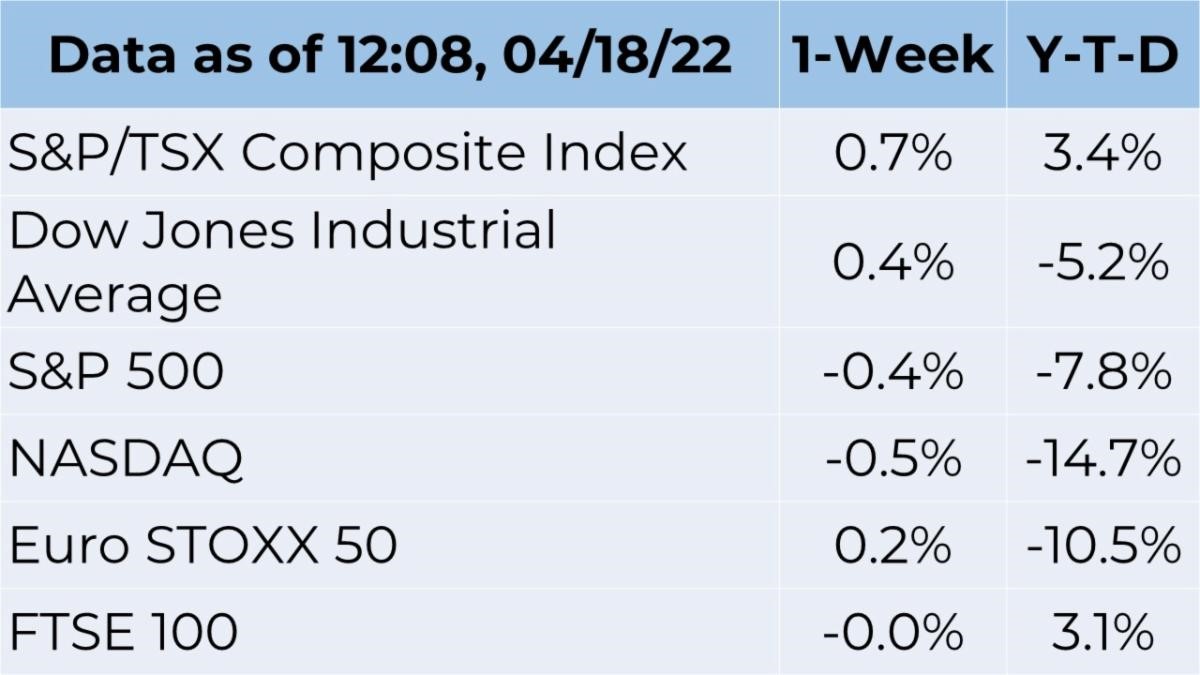Weekly Market Commentary - April 21st, 2022
The Markets
Here’s a riddle: How can inflation be 8.5 percent and 6.5 percent at the same time? The answer is that it depends on how the government measures it.
Determining how quickly prices are rising or falling – and where they may be headed in the future – is not simple. Millions of goods and services are bought and sold every day – shelter, food, transportation, energy, water, education, childcare, equipment and tools, medical care, furnishings, apparel, trash removal, and much more.
South of the border, the government relies on two indexes: the Consumer Price index (CPI) and the Personal Consumption Expenditures Index (PCE). Each index has two versions: headline inflation and core inflation. In Canada, we rely on our own Consumer Price Index, but we examine the data coming from the U.S. as Canadian CPI numbers are often released much later (The most recent Canadian data is from February). While the U.S. economy differs significantly from our own, the American data points are still useful in making educated guesses about economic trends occurring domestically.
Last week, the Bureau of Labor Statistics (BLS) reported that CPI headline inflation was up 8.5 percent in March, and CPI core inflation was up 6.5 percent.
The BLS does not collect every price in every part of the United States. It gathers prices in 75 cities, collecting data from about 6,000 households and 22,000 department stores, supermarkets, hospitals, gas stations, and other establishments. So, the CPI is a measurement that reflects the experience of urban consumers.
CPI headline inflation
Last week, the CPI showed that headline inflation, which includes all price changes collected, was up 1.2 percent from February to March, and up 8.5 percent for the 12-month period that ended March 31. The largest increases in the CPI were:
- Used cars and truck prices +35.3 percent
- Energy prices(fuel oil, gasoline, natural gas, etc.) +32.0 percent
- New car prices +12.5 percent
- Food prices (groceries and eating out) + 8.8 percent
CPI core inflation
The BLS also reported on core inflation, which is the CPI minus food and energy prices, and was lower than headline inflation. The core CPI was up 0.3 percent from February to March, and up 6.5 percent for the 12-month period that ended March 31.
Why would anyone want to exclude staples like food and energy from inflation?
The U.S. government contends that food and energy prices are volatile – food and energy are commodities that trade on exchanges – and can distort inflation readings. “Policymakers are forward-focused. They need guidance on where the inflation trend is headed. High volatility obscures that trend,” explained George Calhoun of Forbes. On the other hand, it is also worth noting that removing the more volatile components, at least currently, results in an inflation number that is lower, and thus more palatable to the average voter, and one could argue that the volatile components that are being removed represent the items that are most important to the average consumer.
By comparison, in Canada, the CPI does not remove volatile components. Instead, Statistics Canada maintains a secondary index, the “Adjusted” price index, where product weightings inside the basket of goods are modified month-to-month based on consumption trends. As a side note, these differences in methodology mean that while American inflation data potentially grants early insight into our own economic situation, it is not possible to do a perfect apples-to-apples comparison.
Last week, major U.S. stock indices declined while the S&P/TSX Composite index remained relatively flat. In the fixed income markets, the yield on 10-year U.S. Treasury notes and 10-year Government of Canada bonds rose last week.
If you have any questions or concerns about your investment portfolios or recent market conditions, please don’t hesitate to give us a call.

Source: FactSet
Survey corner:
Cycling Event (May/June 2022)
Special Events
Ride for Heart fundraiser
Thank you for all your support we've already raised 20% of our goal! Also, the Raymond James Foundation will be matching donations up to $5,000! Let's push through and reach our goal!

Talkin' 'bout my generation
In North America, we often describe groups of people by applying generational labels – Baby Boomers, Gen X, Millennials, and so on. Researchers use these generational cohorts to better understand formative experiences, world views, aging processes, and other issues. See what you know about generational demographics by taking this brief quiz.
- How many generations live in North America today?
- Four (Gen Z, Millennials, Gen X, and Baby Boomers)
- Five (Gen Z, Millennials, Gen X, Baby Boomers, and the Silent Gen)
- Six (Gen Z, Millennials, Gen X, Baby Boomers, the Silent Gen, and the Greatest Gen)
- Seven (Gen Alpha, Gen Z, Millennials, Gen X, Baby Boomers, the Silent Gen, and the Greatest Gen)
- Which generation currently has the most economic and political power?
- Gen Z
- Millennials
- Gen X
- Baby Boomers
- Silent Gen
- Which generation owns the most small businesses?
- Gen Z
- Millennials
- Gen X
- Baby Boomers
- Silent Gen
- Which generation is the most influential on digital platforms?
- Gen Z
- Millennials
- Gen X
- Baby Boomers
- Silent Gen
The answers are below.
Weekly Focus - Think About It
“Finish each day and be done with it. You have done what you could. Some blunders and absurdities no doubt crept in; forget them as soon as you can. Tomorrow is a new day. You shall begin it serenely and with too high a spirit to be encumbered with your old nonsense.”
—Ralph Waldo Emerson, philosopher and poet
Best regards,
Eric Muir
B.Comm. (Hons.), CIM®, FCSI
Portfolio Manager
Tracey McDonald
FCSI, DMS, CIM®
Portfolio Manager
Derek Lacroix
BBA, CIM®, CFP®
Associate Financial Advisor
Answers: 1) d; 2) d; 3) c; 4) b
P.S. Please feel free to forward this commentary to family, friends, or colleagues. If you would like us to add them to the list, please reply to this email with their email address and we will ask for their permission to be added.

